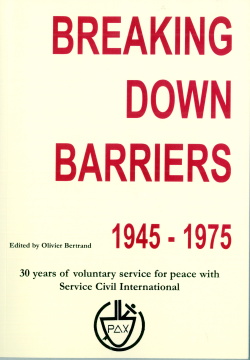Introduction: 1947-1956
In the aftermath of the war, the huge geographic region of Asia was undergoing its own cataclysm. Large areas were engaged in independence struggles, whereas other areas were torn by the Cold War as socialism, communism and capitalism vied for dominance. Strict foreign exchange laws and stringent visa requirements made travel within Asia very difficult. In those circumstances the spread of SCI activities faced strong headwinds, always remained small, and some countries remained completely closed. The first step was in India - a consequence of Pierre Cérésole's earlier earthquake relief efforts. There was always a general compatibility of SCI’s aims with the non-violent movement for Indian independence and Gandhi’s methods. Many second generation volunteers were inspired by this movement, and also wanted to learn more about eastern philosophy and religion.
Achievement of independence in 1947 required a compromise that caused a division of the Indian subcontinent. Predominantly Muslim areas were incorporated into West Pakistan and East Pakistan, with the area of Kashmir (ruled by a Hindu maharajah with a majority Muslim population) still disputed until this day. This Partition caused an enormous displacement of persons - between 12 and 15 million people - as Hindus fled the new Pakistan, and Muslims the new India. In the process at least 1 million people were killed. With the refugees pouring in, Dr. Rajendra Prasad, President of India, (familiar with SCI’s work in 1934) asked SCI’s assistance. SCI replied that they would undertake that action, on the condition that they could also work in Pakistan, thus honoring SCI’s principle of even-handedness. That was accepted and the first team began work in 1949. A Swiss SCI member, Pierre Oppliger, who had taught French to Indira Gandhi when she studied in Switzerland, was in India, and had entrée to high circles and knew Vijaylakshmi Pandit (sister of Nehru, the first Prime Minister of India) and other prominent officials.
The first teams worked in Faridabad, a township set aside for refugees outside of New Delhi, and worked outside of Karachi. Because of the intense heat prior to the monsoon season, other worthwhile projects were pursued in areas at higher elevation seasonally. These early workcamps continued the pick and shovel tradition of SCI – manual labor that did not compete with local labor, with a lifestyle that mirrored local conditions. Women were called sisters, and were in charge of the domestic side, including washing the men’s clothes and sewing. Some outsiders were critical of white men doing the work of coolies, especially as they may not be as effective, given their intolerance to the heat and unfamiliar diet.
Nonetheless, there were larger issues at stake. In this post-colonial period it was important symbolically to show that white people, formerly associated with the overseers and officials, would work side-by-side with Indians or Pakistanis. Additionally, within the Indian society, used to the caste system and a supply of servants, physical work was seen as beneath the more educated. Therefore, an early SCI objective was to demonstrate through ‘Deeds, not words’ the dignity of manual labor, to break down prejudices and blur the lines of superior/inferior. SCI volunteers travelled by bus or fourth class train, (then third class when fourth class was abolished), ate local food and usually slept on the ground or floor in the workcamps. SCI’s non-sectarian stance was also emphasized. Its demonstration of what could be done by ordinary people, without government mandate, was compatible with Gandhian ideals, so it was not an entirely foreign idea. Dorothy Abbot Guiborat, Devinder Das Chopra, Marius and Marianne Boelsma were among these early volunteers and their reflections can be found following this introduction.
Early teams of Western and Japanese volunteers actively recruited students to join them by speaking at colleges and holding meetings. The Oppligers were the unofficial SCI contact point for several years. Pierre Oppliger later was the representative for Swiss Aid Abroad and made his home permanently in Almora, UP. Gradually, a core of experienced Indian volunteers grew and in 1952 a group was formed with Ethelwyn Best designated as the Representative of the British Branch and financed by them. [Ethelwyn had been a member of the first team in 1949-50 but had had to return to England following an injury sustained in a bus accident in the hills.] Her role was to co-ordinate the programs of the LTVs (Long-term volunteers), encourage the development of the young group whose members could only help in their spare-time, fund raise and act as liaison with potential projects and officials. She had her office in Mehrauli (on the outskirts of New Delhi) near the famous landmark of Qutab Mihar. Beginning in the early `50s a small, but steady stream of Indian and Pakistani volunteers were sent to workcamps in Europe. Local groups became active in Calcutta, Madras and Bombay. As the cadre of experienced volunteers increased, the number of foreign volunteers was reduced, and the length of service reduced from 24 months to 18 months. By 1956 a team consisted of 3 volunteers for 18 months.



